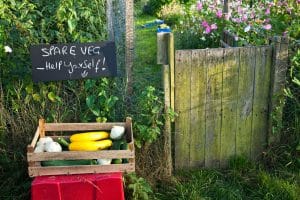We’re all looking towards sustainability and not chucking garden stuff away, whether it be old tools, gluts of veg or clippings.

As you start your great garden clear-up at the end of summer, spare a thought for what you may be throwing away.
Old squeaky tools, blunt shears, bedding plant debris and vegetable gluts may all end up in the bin. Yet there are many easy ways to avoid waste, if we just think about it.
Save seed
You can save seeds from a plethora of veg, including French beans, peas, tomatoes, chillies and courgettes, enthuses seed expert Adam Alexander, whose new book The Seed Detective is published in September.
“Saving your own enables you to have seed which becomes adapted to local conditions, germinates more quickly and has greater viability and, above all, you know its provenance,” he says.
Many seeds can be extracted from mature, ripe crops, cleaned and dried off before storing in an envelope and placed in an airtight Tupperware in a cool, dry spot. Alexander advises people to choose open pollinated varieties from which to extract seeds, as they will come back truer than F1 hybrid types.
Share gluts
Don’t chuck away excess produce that you grow on an allotment or in your veg patch at home. Share them with family, neighbours and fellow allotmenteers, who in turn, may well swap what they have grown with you.
Preserve edibles
If you run out of people to give gluts to, keep veg by blanching and freezing them – you can do this with beans, peas, sweetcorn and others. Chillies can also be frozen or dried, while courgettes, tomatoes, aubergines and onions can be transformed into ratatouille or layered in delicious vegetarian lasagnes for freezing.
Tomatoes can also be made into passata for freezing, while unripe green tomatoes are great for making chutney, which will keep for a year in a cool place, if the jar is properly sterilised and sealed. Gluts of fruit can be made into jams and compotes, while apples and blackberries can be cooked and frozen, to transform into pie fillings for a later date.
Maintain tools
Instead of chucking your secateurs and loppers in the shed, think about how you are going to maintain them, so they will last many more seasons. Clean spades, hoes, rakes, forks and trowels with a stiff brush, to remove soil from the blade and shaft, or give really muddy tools a hose down before drying them with an old towel. You can also oil tools with general purpose oil to help stop them rusting, although more modern stainless steel tools are less likely to rust, says the RHS.
After cleaning blades with wire wool and spraying mechanisms with WD40, sharpen secateurs with a diamond sharpener or sharpening steel. Some secateurs can be disassembled to make sharpening easier.
Let your grass recover naturally from the drought and book your mower in for a service, to ensure everything is in order next year.
Replace annuals with perennials
The cost on the environment of annuals can be high if you consider the plastic pots still used extensively by garden centres, plus transport costs.
Perennials, however, come back year after year, so you won’t have to replace them annually, and can save money as well as promoting more sustainable gardening. If you can’t live without your burst of colourful summer annuals, try growing them from seed, using home-made containers, such as cardboard toilet-roll middles or biodegradable pots widely available in garden centres.
Clean garden furniture
Some garden furniture, such as aluminium sets, weatherproof wicker or plastic, doesn’t need much maintenance over winter, just a quick clean with soap and water before putting it away. However, wood furniture is a different story – even hard wood like teak will need a coat of protector from time to time if you want the original colour to be maintained, although good quality teak can survive with virtually no treatment for many years, according to the RHS.
Softwood such as pine, however, tends to be cheaper, and if you want to sustain it, it will need a coat of preserving stain or paint in dry weather every year, and you’ll need to cover it during the cooler months to avoid damp getting in. It’s also worth putting some rubber or plastic feet over the legs to avoid damp seeping into the wood.
Make compost
Don’t ditch your green household waste, garden clippings and cardboard, because you can transform it into rich organic matter, whether you opt for a regular compost bin with a lid, or an open heap topped with old carpet to retain the heat.
It is important to get the balance right, though. The RHS recommends you aim for between 25-50% soft green waste – such as grass clippings, kitchen veg waste, annual weeds or manure, with the remainder being woody brown material, such as prunings, paper, cardboard, dead leaves or straw. Avoid letting grass clippings become dominant, as they can become a slimy mess on their own, the charity advises.
Use veg space in winter
So, once you’ve harvested your summer and autumn crops, don’t let the space in your veg patch go to waste. Kale, leeks and winter cabbage can all be grown on the plot, but if you can’t be bothered, sow some green manures, which are fast growing and will return
nutrients to the soil and improve its structure.
Mustard sown before mid-Sept can be incorporated in October, while grazing rye can be sown from August to November, to dig in the following spring. Winter field bean and winter tares can also be sown in September for overwintering.
(Article source: Silver Surfers)

